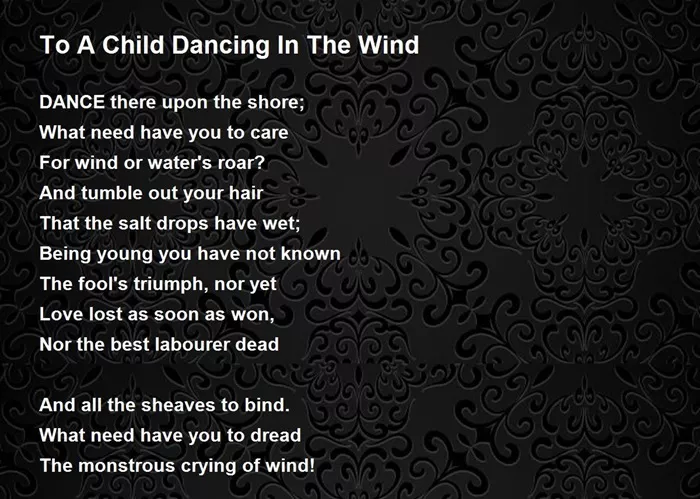Welcome to Poem of the Day – To a Child Dancing in the Wind by William Butler Yeats
William Butler Yeats, one of the most celebrated poets of the 20th century, is known for his mastery of themes like Irish heritage, love, and nature. One of his captivating poems, “To a Child Dancing in the Wind,” invites readers into the realm of innocence, freedom, and fleeting beauty. This article will explain the meaning and significance of this poem, breaking down its lines in a clear and simple way.
To a Child Dancing in the Wind Poem
DANCE there upon the shore;
What need have you to care
For wind or water’s roar?
And tumble out your hair
That the salt drops have wet;
Being young you have not known
The fool’s triumph, nor yet
Love lost as soon as won,
Nor the best labourer dead
And all the sheaves to bind.
What need have you to dread
The monstrous crying of wind!
To a Child Dancing in the Wind Explanation
Theme of Innocence and Freedom
The poem opens with the image of a child dancing in the wind. The wind here symbolizes the forces of nature that are beyond the child’s control, yet the child moves joyfully in it, uninhibited by the struggles and complexities of life. The “dancing” is a vivid representation of innocence, a carefree state that contrasts sharply with the troubles and responsibilities of adulthood. Yeats admires this child’s freedom, suggesting that it embodies a kind of purity untouched by the harshness of the world.
The Contrast Between Innocence and Experience
In the first stanza, Yeats reflects on the disparity between the carefree dancing of the child and the complex, often burdensome concerns of adulthood. The question of focusing on political issues like Roman or Russian politics, mentioned in the poem, underscores the heavy, often serious responsibilities of grown-ups. The speaker expresses how difficult it is to focus on such matters, contrasting it with the lightness and joy of the child’s dance.
The Role of the Observer
In the second stanza, the speaker compares himself with a “traveled man” who has knowledge and experience in the world. This individual represents adult wisdom and the burdens that come with it. Yeats also introduces a “lady at his side” who seems to be in doubt. The presence of doubt in the lady further emphasizes the complex and uncertain nature of adulthood. The child, by contrast, dances in the wind with no such doubts, a metaphor for the clarity and purity of childhood.
The Impermanence of Youth
Another critical element in this poem is the fleeting nature of youth. The child’s dance, full of life and energy, is symbolic of a transient stage in life. Yeats subtly alludes to the idea that childhood’s innocence and freedom will eventually fade away, much like the wind. The poem’s delicate tone suggests that such moments should be cherished, as they will not last forever.
The Wind as a Metaphor
The wind plays a significant symbolic role in the poem. It represents both the freedom and unpredictability of life. Just as the child dances with the wind, the poem suggests that life, with all its uncertainties and challenges, must be embraced. The wind’s unpredictability is a reminder that life itself can be chaotic and uncontrollable, yet there is beauty in surrendering to it with joy and openness.
Conclusion
To a Child Dancing in the Wind is a celebration of innocence, freedom, and the fleeting beauty of childhood. Through the imagery of the child dancing in the wind, Yeats captures the essence of purity and joy before the complexities of adulthood take hold. He contrasts the child’s carefree nature with the burdened lives of adults, suggesting that there is something to be learned from the lightness of youth. The poem encourages readers to reflect on the simplicity and beauty of life’s early stages and to embrace the freedom and joy that come with them.
In essence, Yeats invites us to pause and admire the dance of life, as seen through the eyes of a child, reminding us that sometimes it’s the most innocent moments that offer the greatest wisdom.

